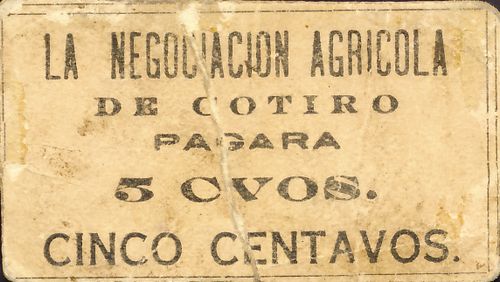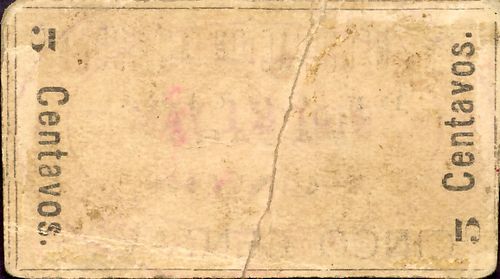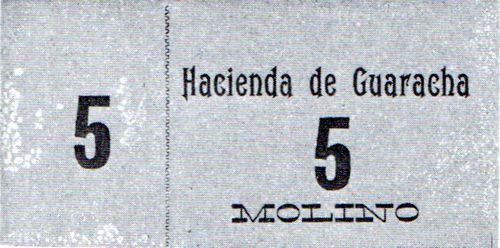Haciendas (northern Michoacán)
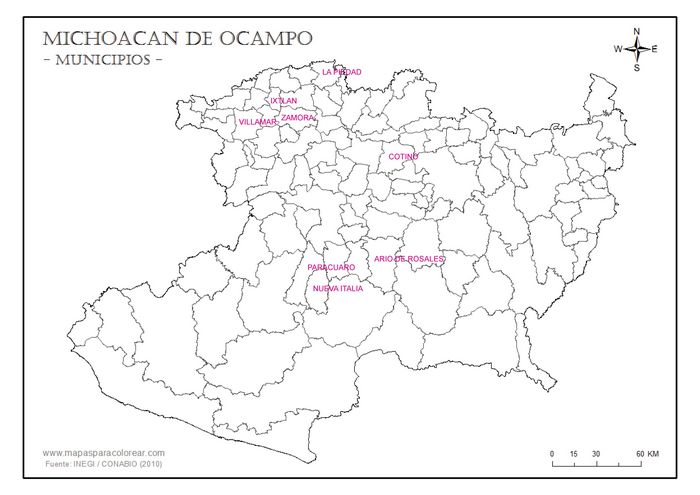
These low value notes will have been used to pay wages to the workers, most probably because of a lack of small change but paying in vales tied the workers even more tightly to the hacienda and its company store (tienda de raya).
La Piedad
Hacienda La Tepuza
This hacienda was owned by Pedro A. Jiménez.
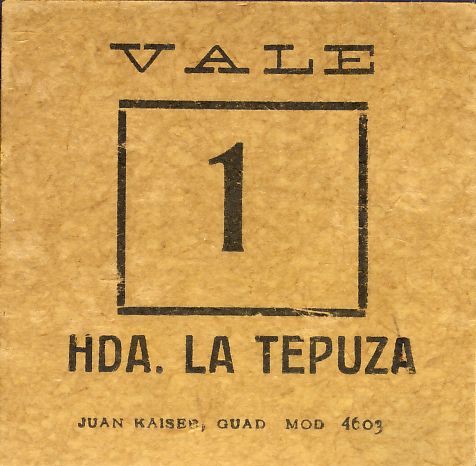
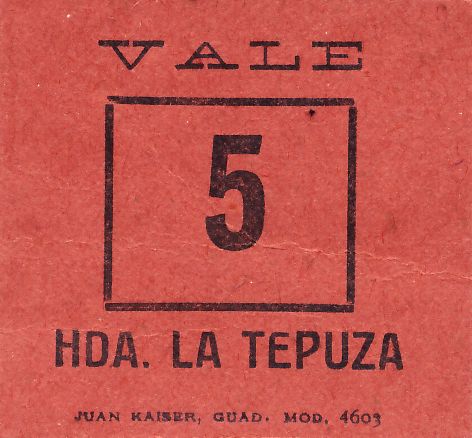
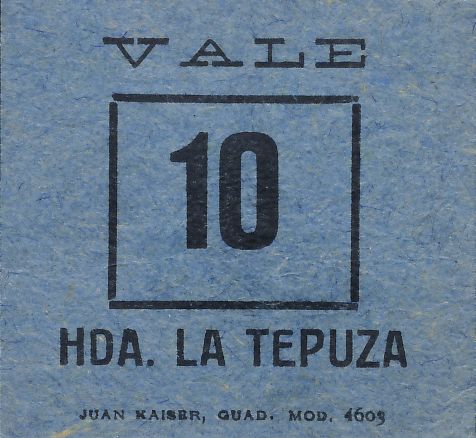
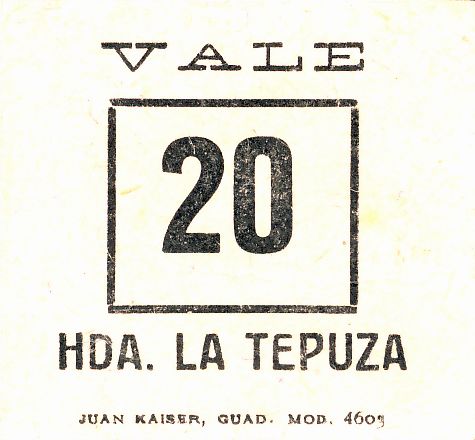
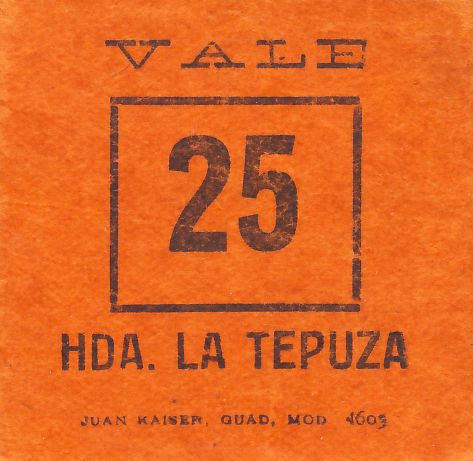
These were produced by Juan Kaiser of Guadalajara. Kaiser printed tokens, mainly for haciendas in Jalisco. These notes are of thick paper or, more often, pressboard and there are a few common designs, most noticeably the round cartón with the denomination on the face and the same in Roman numerals (and often the hacienda’s brand) on the reverse. They usually carried the imprint “J.K.G” (for Juan Kaiser Guadalajara) or some variation, and the number of the order (modelo) which allows the various issues to be dated. These are modelo 4605.
Puruándiro
Hacienda de Villachuato

The Hacienda de Villachuato was considered "the granary of the Bajío" for its high production of corn, sorghum, wheat, beans, alfalfa, sweet potato, pumpkin, onion, sugar cane, tobacco and tomatoes. It was an immense property of 98,963 hectares, or more than 244,000 acresThe Mexican Herald, 10 March 1907.
The hacienda was bought in March 1907 by Fernando Pimental y Fagoaga on behalf of the Compañía Bancaria de Obras y Bienes Raicesibid..
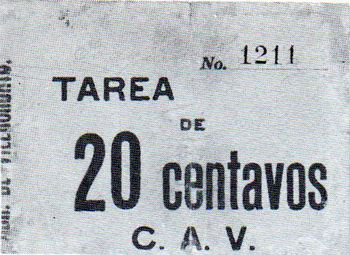
| from | to | total number |
total value |
||
| 20c | includes number 1211 |
This 20c note is dated 13 March 1915. "C. A. V" are the initials of the Compañía Agrícola de Villachuato, which in 1914 had its offices at 2a calle de San Agustín núm. 50, Mexico CityDiario Oficial, 8 March 1914.
The Compañía Agrícola Franco-Mexicana
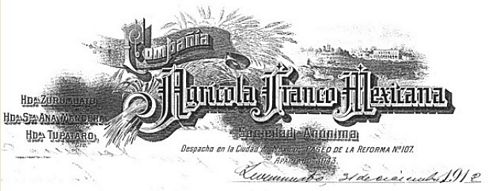 Carlos Markassuza came to Mexico from the Basque region of Spain in around 1872 and became a wealthy landowner. On 1 January 1911 he acquired the Hacienda de Tupátaro in Guanajuato, very close to three others that he already owned in Puruándiro, Michoacán, and in April 1911 he created the Compañía Agrícola Franco-Mexicana, S. A. that grouped together the Tupátaro, Zurumuato and Santa Ana Mancera haciendas.
Carlos Markassuza came to Mexico from the Basque region of Spain in around 1872 and became a wealthy landowner. On 1 January 1911 he acquired the Hacienda de Tupátaro in Guanajuato, very close to three others that he already owned in Puruándiro, Michoacán, and in April 1911 he created the Compañía Agrícola Franco-Mexicana, S. A. that grouped together the Tupátaro, Zurumuato and Santa Ana Mancera haciendas.
In 1910 Carlos brought his seventeen-year-old nephew, Charles Félix Markassuza, from Spain in to be the administrator of his hacienda at Zurumuato. In his letters Charles describes the system for paying the peones.
On Sundays, we go to Mass in the church that borders the hacienda. We put all the employees together on the side that is reserved for us. After Mass, we pay the workers, a process that takes from three to four hours. Every week we need more than 2,000 francs, that is 4,000 pesos.
…
When we need something, we look for it in the tienda; this tienda is on the hacienda itself and belongs to my godfather. The farm workers stock up there, which means that it recovers almost all the money from their pay. By this means, he earns about 30,000 francs per year in the tienda (letter of 6 November 1910)Beñat Çuburu-Ithorotz, “Testimonio fotográfico y epistolar de dos emigrantes vascofranceses“ in Alquimia, Núm. 34, 2008.
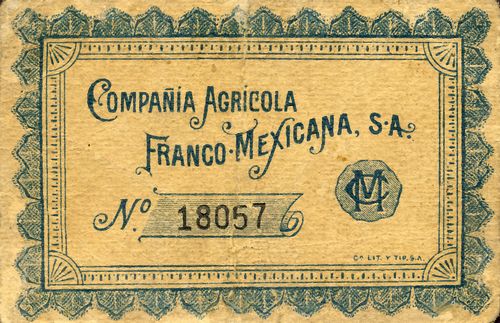
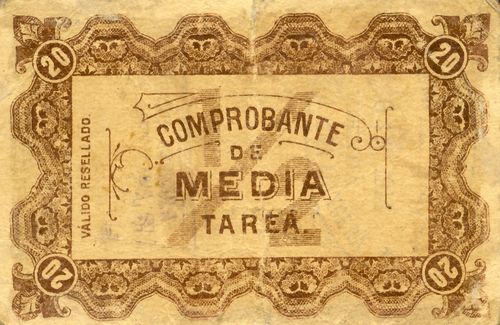
This note is proof of half a task, with the denomination '20', possibly a 50% advance on wages, and needed to be stamped to be valid. It has the monogram ‘CM’ for Charles Markassuza, and was produced by the Compañia Litográfia y Tipográfia, S. A., a publicly quoted company in Mexico City with V. Lions as its Director General.
Ixtlán de los Hervores
Hacienda de San Simón
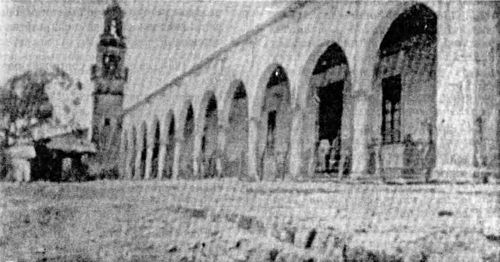
San Simón is a little over 20 kilometres north-east of Zamora. Only a part of the structure of what was the hacienda (the main house and the house of the administrator) and the tower of the sugar mill still survive.
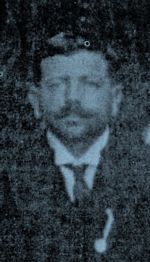 This hacienda, with an area of 9,987 hectares, was sold in 1909 to the agriculturalist Tomás Sánchez for 100,000 pesos. From 1909 until 1949 Tomás’ sons, the brothers Benjamín, Estebán and José María Sánchez, worked it as part of the “Sociedad Sánchez”.
This hacienda, with an area of 9,987 hectares, was sold in 1909 to the agriculturalist Tomás Sánchez for 100,000 pesos. From 1909 until 1949 Tomás’ sons, the brothers Benjamín, Estebán and José María Sánchez, worked it as part of the “Sociedad Sánchez”.
This association was dissolved in 1949 on the death of José María and the small part of the hacienda that had survived the agrarian reforms passed to the control of their sons.
In 1914, the hacienda was confiscated by the Revolution, and an inventory was made by which we know that it had 107 permanent employees, whose weekly salaries were 50 pesos for the administrator and ten for the secretary, while the salary for the rest of the employees were from seven pesos for the granary keeper to $1.05 for the gate keeper. The common labourer was paid 50 centavos per day because they could not be certain to work seven days per week. On payday the line of workers reached to the entrance of the hacienda de la Estanzuela, half a kilometre distance from the central patio, and payday did not finish until sunsetMiguel J. Hernández Madrid, La Comunidad Autoritaria, El Colegio de Michoacán, 1990.


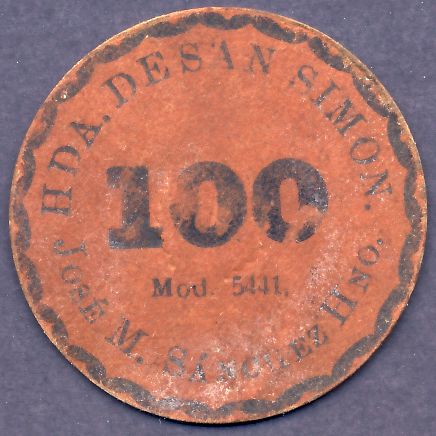
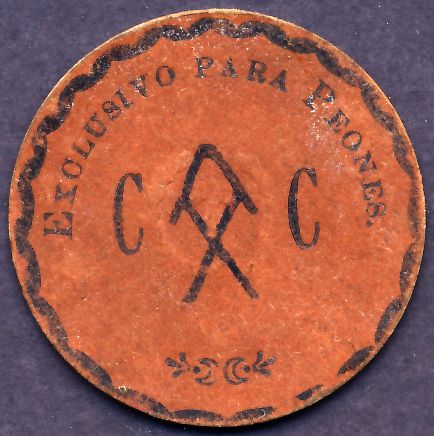
This hacienda had 50c and $1 notes printed by Juan Kaiser as modelo 5441, with José M. Sánchez Hno on the face and the hacienda's brand on the reverse. The notes do have have the imprint "J.K.G" so might date to after Juan Kaiser's death in 1916.
There is also record of a small circular cartón for 50 L/S MaizIgnacio de Jesús Sánchez Montes, “Fichas de la Hacienda de San Simón, Michoacán”, in El Boletín Numismático, No. 201, Oct.-Dec. 2003.
The hacienda also used metal tokens in eight different denominations, again with the hacienda’s brand on the reverseibid.. These were used until 1920 according to the information of Antonia CoronadoInterviewed by Teresa Lara Campos during May 2003.
Villamar
Hacienda de Guaracha
This colonial hacienda, in Villamar, was one of the principal sugar producer in the area. By 1915 its owner, Diego Moreno, President of the Banco de Jalisco, had died and it was run by his heirs. It produced a series of notes dated 16 September 1915, printed by José María Iguíniz of Guadalajara.
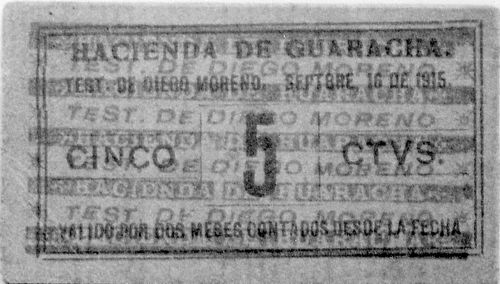
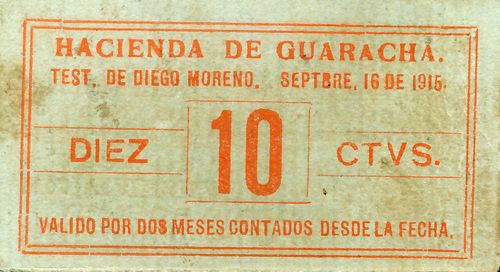
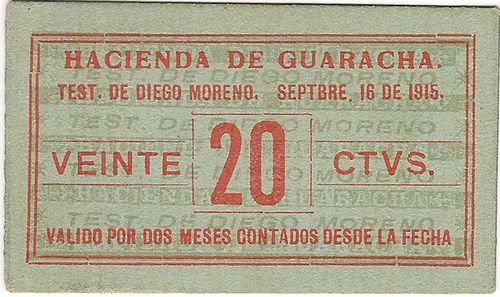
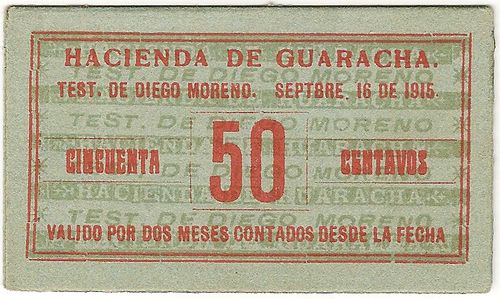
It also had coupons for the various units - botica (pharmacy), pasturas (pasture), huerta (orchard) and molino (mill). Known coupons are
| 1c | 2c | 3c | 5c | 10c | 15c | 20c | |
| Botica | X | X | X | ||||
| Pasturas | X | X | X | X | |||
| Huerta | X | X | X | ||||
| Molino | X | X | X | X |

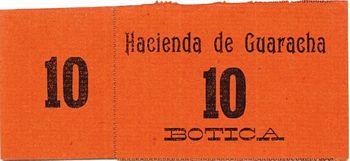
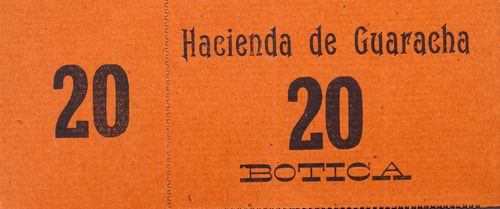
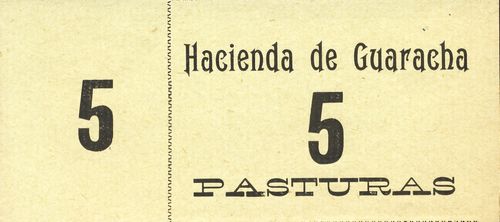
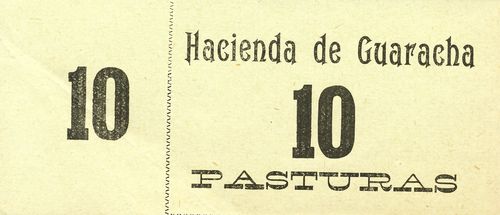
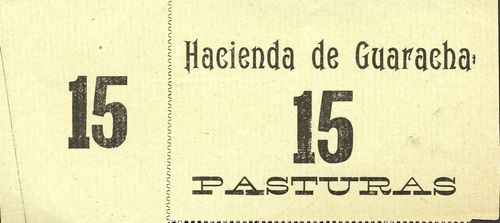
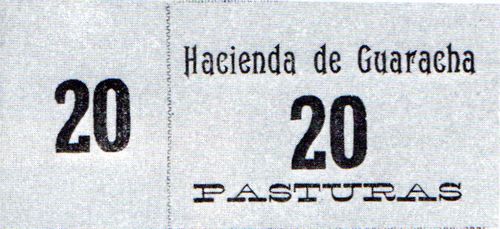
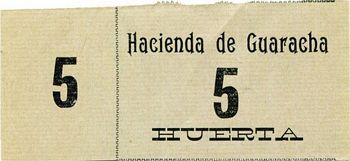
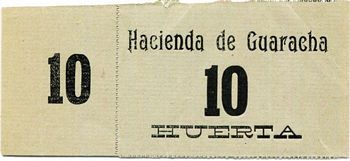
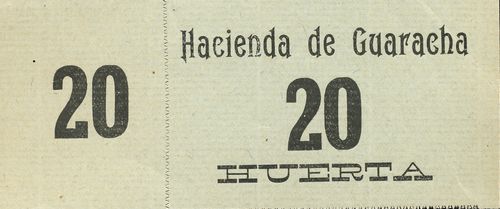
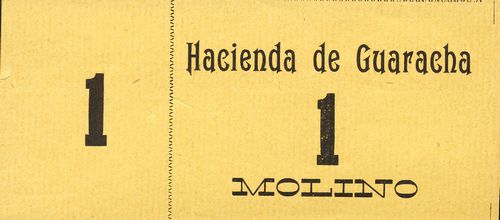
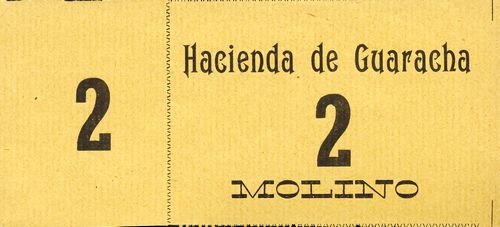
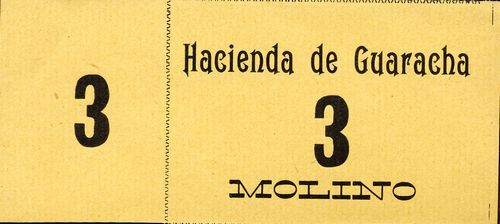
Zamora
Las Haciendas de Cerrito y La Rinconada
The negociación García Hermanos, of Luis García Méndez and his brothers, operated jointly from the haciendas of La Rinconada, Cerrito and Santiaguillo to which over the years of good business other lands were added. The hacienda of La Rinconada, with 784 hectares in 1889, came to have 2,148 hectares with 43% of irrigated land. The hacienda de Cerrito, initially of 246 hectares, came to have 1, 680 hectares of which 67% was irrigated.
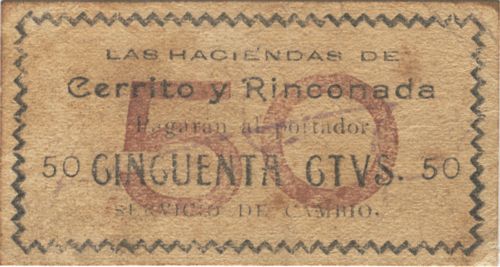
We know of a 50c note.
Hacienda El Llano
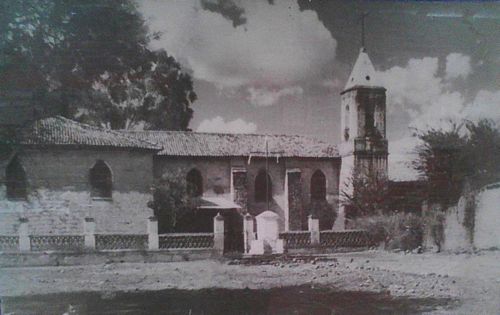
The church, El Llano, 1901
The hacienda El Llano in Zamora was administered from 1911 until 1914 by Rosendo Tamayo, who was followed by Diego Dávalos. The hacienda was then awarded to the Carrancista general Joaquín Amaro, who passed it to Luis Gutiérrez with Luis Pulido, a native of Los Reyes, Michoacán, as administrador until 1915.
Around March 1915 the then overseer, Abundio Carriedo, issued some cartones with his signature. Afterwards they used a stamp of the hacienda and issued some more, until Señorita Maria Dolores Méndez Verduzco learnt of them and called them in. So they were in use for just a couple of months. María G.(?) Dávalos was in Mexico City at this time and disowned the issue as soon as she learnt of it.
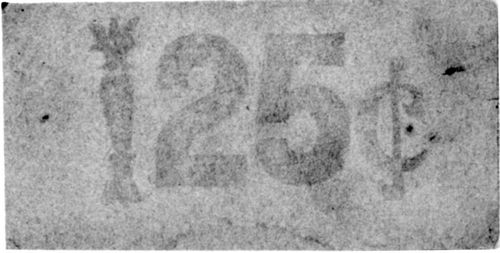
This note is dated 26 June 1915.
Lola Méndez then took the hacienda from these Carrancistas and it was administered by Margarito García on her behalf. In 1916 María Mercedes Dávalos asserted her legitimate rights and recovered the hacienda from Lola Méndez, appointing Germán Rico, a neighbour of Chavinda, Michoacán, as administrador. Jorge Dávalos became administrator in 1917 and María continued to own the hacienda until 1934..
In July 1917 a couple of people tried to get the Presidencia Municipal to encash some fichas but the Presidencia acknowledged that Dávalos had no responsabilityAMZ, sección Secretaría, caja 58, Exp. 31.
Hacienda Los Espinos
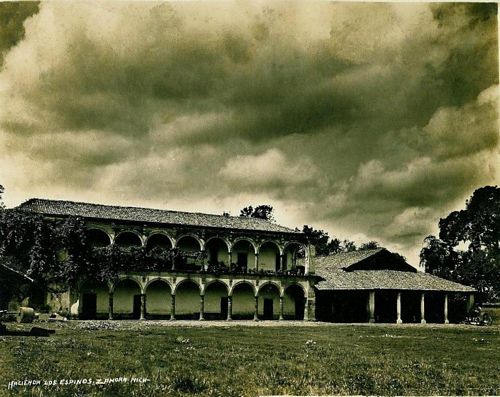
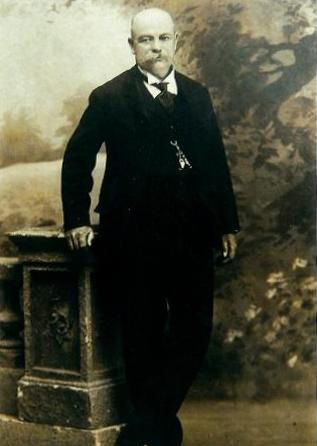 The main house at Los Espinos, according to experts, dates from the mid-eighteenth century, although it was built in different stages, concluding its construction in the late nineteenth century. Zamora’s Municipal Archive and the directory The Haciendas of México (1886) place on record that at the end of the nineteenth century, the hacienda belonged to Marcelo Matos who sold the property to Benito Magaña Peña who came from the municipality of Tlazazalca to settle permanently in Zamora after buying the hacienda.
The main house at Los Espinos, according to experts, dates from the mid-eighteenth century, although it was built in different stages, concluding its construction in the late nineteenth century. Zamora’s Municipal Archive and the directory The Haciendas of México (1886) place on record that at the end of the nineteenth century, the hacienda belonged to Marcelo Matos who sold the property to Benito Magaña Peña who came from the municipality of Tlazazalca to settle permanently in Zamora after buying the hacienda.
Apparently, in Los Espinos Benito Magaña did not produce special notes (at least we do not know about the existence of any) but, according to the evidence, used the notes issued by the municipality and counter stamped them in red ink. At least on the 50 centavos notes he also embossed his name. These two counterstamped municipal notes are the only ones reported and they both came from inside the hacienda.
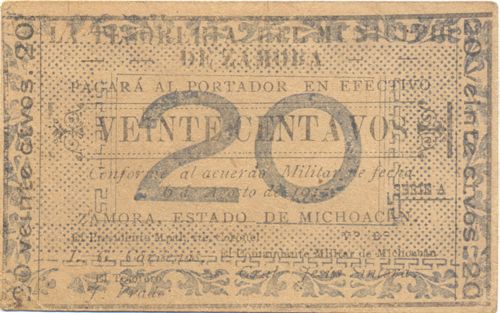
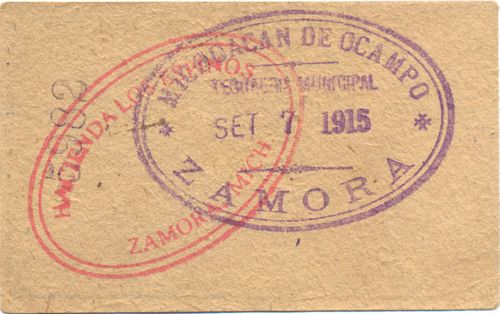
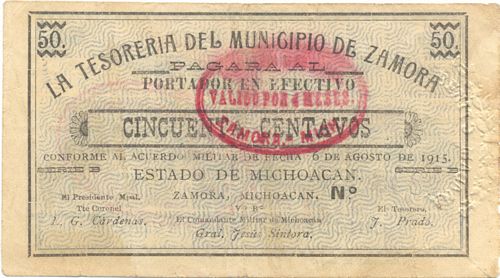

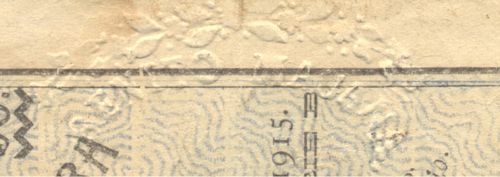
(based on "Report of Hacienda Los Espinos Paper Money" by Ricardo Vargas Verduzco in USMexNA journal December 1915)
Cótiro
La Negociación Agrícola de Cótiro
